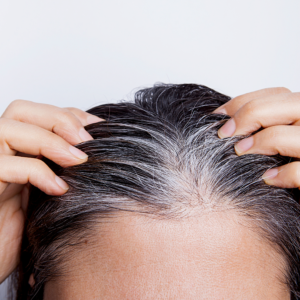WHAT IS IT?
Traction alopecia (TA) is a type of hair loss, typically at the frontal hairline, but may be found in any area (crown, temples) where hair and scalp have been kept under tension or exposed to glue or friction for extended periods of time. Over time the hair loss may become permanent.
Traction Alopecia is a 100% preventable hair loss syndrome.
TA affects as many as 1/3 of all women of African descent. Even more alarming, in a study surveying African American girls between the ages of 5 and 14 years old, 18% showed signs of TA.
TA can be classified into 3 stages:
- prevention those at risk who have not yet experienced signs or symptoms
- intervention those with mild to moderate hair loss – treatment has high success rate
- remediation those with severe hair loss and permanent scarring – treatment has lower success rate
WHO IS AT RISK FOR TA?
Persons of any gender, race, or age who traumatize their hair follicles with repeated and prolonged wearing of braids, ponytails, cornrows, locks, weaves, rollers and extensions.
WHAT ARE THE SYMPTOMS OF TA?
Traction Alopecia looks like:
- Hair loss, typically at the frontal hairline but may be any area where hair was kept under tension (crown, temples) or glued down for extended periods of time.
- Redness, pimples, and crusts may be present.
- A region of hair loss along the frontal hair line with the retention of shorter, finer hairs in a linear pattern is often seen and is known as the “fringe sign”.
- In the later stages thinning and balding may present.
Traction Alopecia feels like:
- Pain, itch, and sensitivity at the site.
WHAT CAUSES TA?
TA is the result of hair follicle trauma caused by repeated and prolonged wearing of braids, ponytails, cornrows, locks, weaves, rollers and extensions. This especially includes styles that require bonding glue or thread. Recent studies have suggested that hair that is relaxed and/or colored is more susceptible to TA.
TA is not limited to modern women of African descent, in fact, the disorder was identified as early as 1907 in Greenlandic women who wore traditional hairstyles with tightly coiffed buns. Similar observations were made in the mid-late 1900s in Japanese and French peasant women and Sikh males who wear turbans.
Deeper than hair:
The psychosocial impacts of hair loss must also be considered. In a study of South African Black women who presented to a dermatologist with alopecia, 56.3% reported reduced quality of life with regard to self-image, and 34% reported negative impacts to relationships and interactions with people. These data represent small studies but reveal an enormous burden of longstanding social, cultural, and spiritual wounds caused by hair loss.
WHAT CAN BE DONE ABOUT TA?
Solutions for TA depend on the stage of the disease.
The right diagnosis is the KEY! The signs and symptoms of TA can mimic those of other hair loss disorders. See a certified trichologist or dermatologist who specializes in hair loss to properly identify any hair loss issue.
Prevention:
Education is the key! We must spread the word about the risk factors and signs/symptoms of TA. Proper hair care including, shampooing, moisturizing, scalp descaling, and safe, attractive, and easy-to-maintain cuts and styles is essential. Youth, parents, children and adolescents should seek guidance from a trichologist or experienced cosmetologist as a family to assure a common understanding. The education of youth presents the greatest opportunity for intervention because hair follicles are most vulnerable during this period.
Intervention
- In its early stages, TA can be reversible because the hair follicles remain intact. The most important strategy is a change in hair grooming that significantly reduces the intensity and duration of tension. In addition, it is important to avoid and/or reduce high heat styling, bonding glue, sew-ins, chemical colorants and relaxers.
- Every effort should be made to eat a healthy diet rich in whole, unprocessed foods high in micronutrients, protein, and healthy fats. A trichologist may assist with diet and supplement recommendations and low-level laser therapy.
- If there is evidence of inflammation or infection you should see a medical provider who may prescribe oral, injectable, or topical corticosteroids and/or antibiotics. To enhance hair regrowth, you may also be prescribed oral or topical Minoxidil along with platelet-rich plasma, exosome and micro-needling treatments. Peri-menopausal and menopausal women should also address hormone status and consider hormone replacement therapy.
Remediation
Once TA has progressed, areas of hair loss are typically large and involve permanent scarring. A specialized exam called trichoscopy (taking images using a high magnification camera) of the scalp should be performed by a trichologist to determine the appropriate next steps. Depending on the results you may consider options such as cranial prosthetics (“medical” wigs), hair transplant using techniques such as micro-grafting, mini-grafting, and follicular unit transplantation. Transplantation may be effective; however, such options are expensive, painful, and require extended follow-up and recovery times. Meticulous documentation should be performed to facilitate insurance reimbursement, if available.
Experiencing symptoms of TA? DO NOT WAIT!
Get help from our certificated trichologist (hair loss specialist)
REFERENCES:
- Billero V, Miteva M. Traction alopecia: the root of the problem. Clin Cosmet Investig Dermatol. 2018;11:149-159. Published 2018 Apr 6. doi:10.2147/CCID.S137296
- Dlova NC, Fabbrocini G, Lauro C, Spano M, Tosti A, Hift RH. Quality of life in South African Black women with alopecia: a pilot study. Int J Dermatol. 2016;55(8):875-881. doi:10.1111/ijd.13042
- Gathers RC, Mahan MG. African American Women, Hair Care, and Health Barriers. J Clin Aesthet Dermatol. 2014;7(9):26-29.
- Hair Wigs and Extensions Market – Global Outlook and Forecast 2021-2026 https://www.reportlinker.com/p05822878/Hair-Wigs-and-Extensions-Market-Global-Outlook-and-Forecast.html?utm_source=GNW
- Pratt LA, Brody DJ. Depression in the U.S. household population, 2009-2012. NCHS Data Brief. 2014;(172):1-8.
- Pulickal JK, Kaliyadan F. Traction Alopecia. [Updated 2021 Aug 12]. In: StatPearls [Internet]. Treasure Island (FL): StatPearls Publishing; 2021 Jan-. Available from: https://www.ncbi.nlm.nih.gov/books/NBK470434/






